take a final walk with me around our front yard garden...
Tuesday, May 31, 2011
Friday, May 27, 2011
herb infused water
it seems there are many of us here in this space with a love for herbs and their many uses. i thought i would share yet another way to enjoy some of my favorites.

i have been feeling a bit parched these days and have decided to make an effort to hydrate myself more. especially with this heat spell we are having here (it almost hit 90 degrees yesterday!)
sometimes i crave a little flavor and thought i would make some herb infused water.

i used lemon verbena,

anise hyssop

and peppermint.

i harvested a small bouquet of each herb, stuffed them in their own jar and simply poured filtered water over each one. i let them sit overnight and by morning the water was packed with flavor.
add a little lemon or lime and some ice and voila! an herbal concoction that hits the spot.
there are many more I would like to try including basil, borage (which has a cucumber flavor), and pineapple sage.

drinking eight glasses of water a day just may be a breeze after all.

i have been feeling a bit parched these days and have decided to make an effort to hydrate myself more. especially with this heat spell we are having here (it almost hit 90 degrees yesterday!)
sometimes i crave a little flavor and thought i would make some herb infused water.

i used lemon verbena,

anise hyssop

and peppermint.

i harvested a small bouquet of each herb, stuffed them in their own jar and simply poured filtered water over each one. i let them sit overnight and by morning the water was packed with flavor.
add a little lemon or lime and some ice and voila! an herbal concoction that hits the spot.
there are many more I would like to try including basil, borage (which has a cucumber flavor), and pineapple sage.

drinking eight glasses of water a day just may be a breeze after all.
Thursday, May 26, 2011
Garden patterns and experiments
Returning to the garden after being out of town, days of rain, and being too busy with work overwhelms me. There is so much to weed! So today I decided to weave working in the garden into my studio time, and do a little bit throughout the day. This morning I picked strawberries, (harvesting takes time too!) washed them, and froze ones that were a little soft from rain. They will be great for summer smoothies while the firmer ones are perfect for eating right now. Or perhaps I'll make a strawberry shortcake for the long weekend.
This afternoon I freshened up a few vases to spread around the studio while I do my big bi-annual studio cleanse. Bringing the garden inside keeps my spirits lifted while I work.
Then this evening I harvested and pulled all the spinach, some of which had already bolted. It filled a garbage sack full, and since it's way more that we can eat, we'll be sharing with friends. Next we plan to plant okra in the spinach plot and my husband wants to try using the spinach plants as mulch (he's the one who has all the bright garden ideas!). So I spread them along the edges of the plot, leaving space in the middle for the okra seeds. In a nearby area, we are using the dried stalks left in the ground from last year's okra as a natural trellis for the sugar snap peas. It's working pretty well so far, but I think we may space a few wooden stakes for extra support.
Wednesday, May 25, 2011
herbal shampoo
for one reason or another, my gardening sensibility has always revolved around growing things that are useful. to me, when speaking of gardening, useful most often means edible. and this is probably why i have little interest in growing plants that are merely pretty to look at (though, this has been changing a bit in the past few years). beyond edible, however, there are many other practical uses for plants. plants can be used for medicinal purposes, in body care products, for dyes, among other uses. and, as a bonus, many of these plants are also pretty to look at.
when we moved into my house a year and a half ago, i was not so interested in the two rose bushes that were planted in the perennial bed in our backyard. aside from some childhood memories of my grandfather tending to his rosebushes at their old house in new jersey, i have no attachment to roses. but then i started to think about what uses those roses would have. and they survived the summer. i picked the roses and dried them and have been using the petals as ingredients in bath soaks and batch after batch of herbal shampoo.
as you think of what you'd like to plant in your garden this year, maybe take some time to think of what you'd like to make with your garden at harvest time. and plant accordingly.
rosemary rose herbal shampoo
{adapted from methow valley herbs}
ingredients:
8 oz boiling water
2 teaspoons of dried rosemary
2 teaspoons of dried rose petals
4 ounces liquid castile soap
3 Tablespoons aloe vera juice
¼ teaspoon of jojoba oil
30 drops of pure rosemary essential oil
place the rosemary and rose petals in a jar and fill to 8 ounces with boiling water. cover immediately and let it stand until the jar has cooled. strain out the herbs, and pour the water into a bottle or whatever container you will be storing your shampoo in. add the castile soap, aloe vera juice, jojoba oil, and rosemary essential oil.
*note: this shampoo is much more watery than the kind you buy in the store, so it takes some getting used to. i've found that it works best to give the bottle a gentle shake before each use to make sure it's properly mixed, and then squirt a little bit straight onto my head (i used to pour some shampoo in my hands, lather it, then put it on my hair--this doesn't work so well with this type).
i will say, i've been using this shampoo for almost a year and it works great! i love not having to purchase shampoo every few months, knowing exactly which (very few) ingredients i'm putting on my head, and reducing packaging waste. not to mention, taking advantage of the usefulness of my garden.
Tuesday, May 24, 2011
perennial plant sale & care

last week i went to a perennial plant sale in our neighborhood. this neighbor has tended to her yard for over 30 years & has a bounty of plants to share. to say she is an incredible gardener is an understatement; her yard is in full bloom with a diversity of flowering native plants covering every inch of green space.
i usually purchase my perennial plants from local nurseries and hardware stores. although i have had great success with my plants, the act of purchasing plants from a neighbor is more sustainable and ecologically friendly. her plants mature in the rich soil from her garden beds instead of potting soil with chemical fertilizers. additionally, her wealth of knowledge is invaluable.


our neighbor provided information on each plant, including its fragrance, blooming season, propagating rate, and ideal habitat. once i chose my plants, she dug them up, wrapped them in a recycled plastic shopping bag & sent me home with information for caring for my new plants.

instructions for caring for your freshly dug perennials:
1. pot them up and put them in a sheltered spot.
2. keep the roots damp at all times.
3. when the foliage perks up & new growth starts to show,
the plants are ready to plant in the ground.
4. keep the plants damp until well established.

this is just another way of sharing in the garden & exchanging knowledge. once my plants mature, i plan to share them with friends & family. the community that is built through the simple act of gardening keeps me coming back & even more excited. if you have any mature perennial plants that are crowding your garden, i encourage you to share them with those around you!
Monday, May 23, 2011
herbs
it has been raining non-stop here. the herbs love it and have taken off.
a few summers ago i volunteered at an herb garden and learned so much information about these edible plants. some herbs i grow in pots, like rosemary and fruity sage, as they are not hardy in zone four climates. as mentioned earlier, i grow chocolate mint, apple mint, and spearmint in pots to keep them somewhat contained. other herbs i grow in the beds near my front stoop. it's important to have your herbs nearby so you can hop outside and snip a few branches/leaves when you are preparing dinner.
here are some of our favorites(as they look today in the garden) and how we use them:

lemon balm. okay, i can hear you now. lemon balm is such a pain. it is true that lemon balm can spread but this just means that you have to use it. we love lemon balm fresh or dried in teas (hot or cold). i hear that it makes a lovely, lemony pesto when combined with garlic, olive oil and spices. a must try this summer. be creative and try substituting lemon balm whenever a recipe calls for lemon peel.
we cut this herb back probably twice a summer, which keeps it under control. every spring, it's the first herb that greens up and begins to grow. i love how lemon balm smells and even though it can be aggressive in the garden, i like having it in my herb bed.
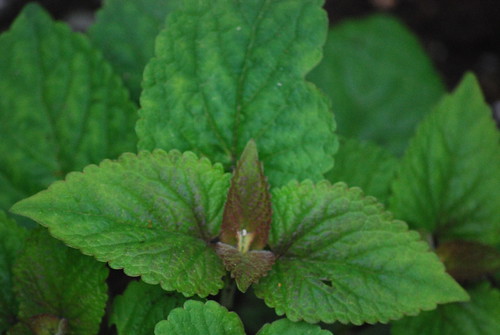
anise hyssop.
this herb is so nice on fresh fruit salads. anise hyssop and watermelon are especially wonderful. a sprig of anise hyssop is also great in iced tea! an added bonus is that bees really like anise hyssop and we have four hives in our backyard. we just added anise hyssop to our garden last summer, and i'm happy we did.

chives.
i don't think i can imagine a garden without chives. so many uses for this easy-to-grow herb. we love making chive vinegar with the blossoms or adding the blossoms to salads. chives are great in stir fries and wonderful additions to butter or cream cheese.
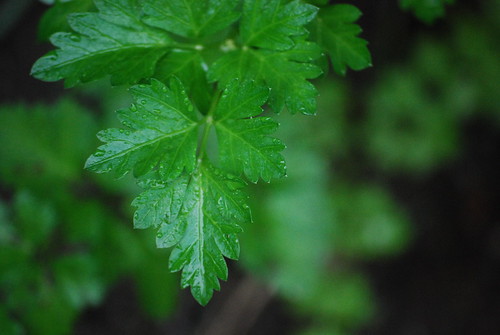
parsley.
great for tabouli, chopped into salads, made into pesto. the list goes on and on.
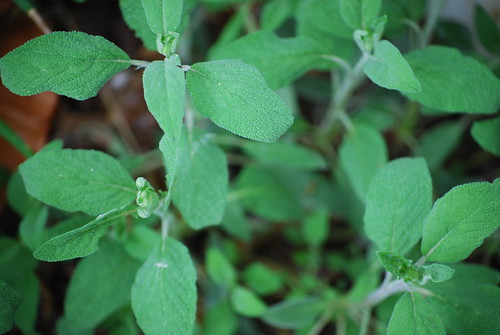
sage.
i love that sage is still going strong in november when we want it to flavor our thanksgiving dishes. we also love fried sage leaves (so good!) in risotto.
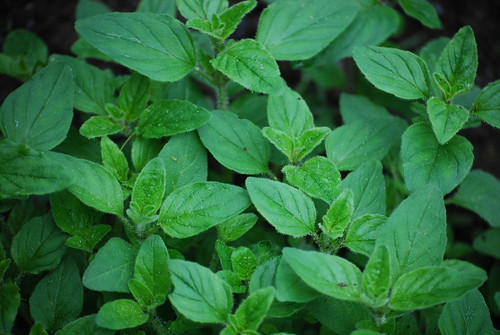
oregano.
each summer we try to cut large bunches of oregano to hang from the rafters of our shed so that we can have a large jar of dried oregano for our pantry. a wonderful addition to pasta sauces.
we also grow cilantro (which is very tiny and hard to photograph at this date).
all of these herbs except for parsley (a biennial) and cilantro (an annual) are perennial and are fairly low-maintenance, in my opinion. it's nice to have herbs to use in the kitchen while we are waiting patiently for garden vegetables.
which herbs are your favorites and how do you use them in your kitchen?
a few summers ago i volunteered at an herb garden and learned so much information about these edible plants. some herbs i grow in pots, like rosemary and fruity sage, as they are not hardy in zone four climates. as mentioned earlier, i grow chocolate mint, apple mint, and spearmint in pots to keep them somewhat contained. other herbs i grow in the beds near my front stoop. it's important to have your herbs nearby so you can hop outside and snip a few branches/leaves when you are preparing dinner.
here are some of our favorites(as they look today in the garden) and how we use them:

lemon balm. okay, i can hear you now. lemon balm is such a pain. it is true that lemon balm can spread but this just means that you have to use it. we love lemon balm fresh or dried in teas (hot or cold). i hear that it makes a lovely, lemony pesto when combined with garlic, olive oil and spices. a must try this summer. be creative and try substituting lemon balm whenever a recipe calls for lemon peel.
we cut this herb back probably twice a summer, which keeps it under control. every spring, it's the first herb that greens up and begins to grow. i love how lemon balm smells and even though it can be aggressive in the garden, i like having it in my herb bed.

anise hyssop.
this herb is so nice on fresh fruit salads. anise hyssop and watermelon are especially wonderful. a sprig of anise hyssop is also great in iced tea! an added bonus is that bees really like anise hyssop and we have four hives in our backyard. we just added anise hyssop to our garden last summer, and i'm happy we did.

chives.
i don't think i can imagine a garden without chives. so many uses for this easy-to-grow herb. we love making chive vinegar with the blossoms or adding the blossoms to salads. chives are great in stir fries and wonderful additions to butter or cream cheese.

parsley.
great for tabouli, chopped into salads, made into pesto. the list goes on and on.

sage.
i love that sage is still going strong in november when we want it to flavor our thanksgiving dishes. we also love fried sage leaves (so good!) in risotto.

oregano.
each summer we try to cut large bunches of oregano to hang from the rafters of our shed so that we can have a large jar of dried oregano for our pantry. a wonderful addition to pasta sauces.
we also grow cilantro (which is very tiny and hard to photograph at this date).
all of these herbs except for parsley (a biennial) and cilantro (an annual) are perennial and are fairly low-maintenance, in my opinion. it's nice to have herbs to use in the kitchen while we are waiting patiently for garden vegetables.
which herbs are your favorites and how do you use them in your kitchen?
Friday, May 20, 2011
the perfect spring lunch

as i was walking the garden yesterday i realized how hungry i was and how much food there was to be eaten right in my own back yard. the chives are blooming and caught my eye. in i went for a pair of scissors for a snipping.

next i headed to the chicken coop to find a few eggs. i thanked our hen

and then grabbed a basket and cut some salad greens.

then off to find some strawberries for dessert.



the perfect spring lunch.

and how satisfying to know that it came from just a few steps away.
soft scrambled eggs with ricotta and chives
4 large eggs
1 tablespoon chopped fresh chives
1/4 teaspoon coarse salt
1 tablespoon butter
1/2 cup fresh ricotta cheese (room temperature)
2 slices whole grain bread or whole grain baguette slices, lightly toasted and buttered
whole chives (optional)
whisk eggs, chopped chives, and 1/4 teaspoon salt in medium bowl until well blended. melt butter in skillet over medium heat. add eggs and stir until eggs are almost cooked but still runny in parts. remove from heat. add ricotta and stir just until incorporated.
arrange toasts or baguette slices on plate. spoon scrambled eggs atop toasts. sprinkle with more salt and pepper. garnish with whole chives.
Thursday, May 19, 2011
A moment
Taking a moment to walk around the garden in the rain, to smell the roses and peonies, and observe water droplets on the daisies and irises.
Baby robin update: the three babies are getting their grey fluff, and as I type this, both parents are perched nest-side with food in beak.
Baby robin update: the three babies are getting their grey fluff, and as I type this, both parents are perched nest-side with food in beak.
Wednesday, May 18, 2011
sharing the garden love
you all already know about my love for gardening in a community, so i suppose this is just an extension. even if you don't participate in a community garden, there are plenty of other ways to get together with others over a shared love for gardening. i truly believe that passion for growing food or other plants brings people together like nothing else.
this past weekend i drove over to the other side of town to a complete stranger's house where i, along with about eight other enthusiastic gardeners, was the recipient of a huge garbage bag full of plants. this kind gardener was in dire need of thinning out the perennials in her beautiful backyard garden, so she put the word out on a local city-wide gardening list-serv and we joined her for an afternoon of digging what she no longer wanted. i went home with valerian, false indigo, globe thistle. oriental poppies, and brown eyed susans, along with a few mystery plants (i should have been more organized in my collection of plants!). even if your town or city doesn't have a gardening list-serv, this time of year, many people give away plants for free via freecycle or craigslist.
this afternoon, in the spirit of giving back what i had received, i drove around town delivering some surplus seedlings that i didn't have room for, as well as a couple of perennials that i myself had dug up out of my own garden. i've recently read about a bunch of plant & seed swaps around town, but i haven't been able to make it to any of them yet. i think next year, i'd love to host a small swap with some of my gardening friends- we could divide up who starts which seedlings early, and swap any excess seeds, seedlings, of perennials that we no longer want or need to be divided.
it's all part of the shared love of growing. tending.
Tuesday, May 17, 2011
symphony of greens
this is a dedication to all of the salad greens out there who fill our plates & warm our tummies. you make gardeners & farmers alike so happy & your harvest is plentiful. we thank you for your abundance & ease of growing.
i am a personal fan of the bounty of greens growing in our front yard garden. when we plan our garden, i use every bit of my restraint as to not purchase every variety or packet of seeds. this year we settled for only four varieties, although i would have been absolutely content to fill our entire beds with the goodness of greens.

one variety of huge success in our garden is the "encore" lettuce mix from johnny's catalogue. this mix includes green & red oakleaf, green & red romaine, and bibb among a few others. we simply scattered the seeds on top of the soil & watered. within a month we had an abundance of fresh greens perfect for light salads.

of course, a garden is not complete without kale. i am a serious believer in kale. we start our red russian kale from seed & then transplanted it into our beds very early in the season. last year we even over-wintered some of our plants. once the snow melted we were harvesting our kale & preparing wilty greens & kale chips.

spinach is another must for the perfect spring salad. our red cardinal spinach from johnny's catalogue is the tastiest when its leaves are harvested early & paired with ripe strawberries. many gardeners claim to have difficulty growing spinach. thankfully i have not experienced this, but i have noticed that the germination rates & maturity are much slower than other greens. the advice i give is to plant early so your plant has time to grow before the summer's heat sets in.

& as always, a mesculin mix is necessary. the beautiful thing about our mix, the "ovation" greens mix from johnny's, is you can plant it almost anywhere & it will grow abundantly. perfect for containers or beds, this mix packs a spicy punch & will rock any salad lover's world.
so get out there & scatter some of this goodness in your garden.
Monday, May 16, 2011
garden pests: cutworms
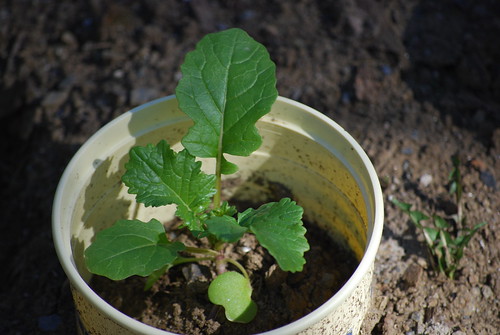
this year as soon as we transplanted our broccoli, broccoli raab, brussels sprouts and cabbage seedlings, we installed cutworm collars. after two seasons we know (and perhaps we should have known after just one) that cutworm collars are necessary to save us the heartache of waking up only to find all of our brassica seedlings cut off at the stem.
cutworms are active in may and june. if you've been digging in your soil and have noticed a red pupa case, beware. these pupae will turn into cutworm moths which will lay eggs and produce more cutworms. the worms are grayish brown and usually will curl up if disturbed. a quick google search will provide you with photos of the worm, the moth, and the pupa case.
the solution is easy. just install a collar around each and every small seedling that you plant, particularly the brassica crops. we cut up old yogurt containers to make our own. the collars need to be pressed firmly into the soil to make an effective barrier. when the seedling grows and is sturdier, you can easily remove the collar and save it for next year.
by paying attention to the insects in your garden, you can garden smarter.
do you use cutworm collars?
Friday, May 13, 2011
re-purposed planters

i have a plethera of pots and planters in the garden. some from the nursery. some from garage sales and thrifts stores. and some from my neighbor's trash. but my favorites are the ones that have come from the recycling bin, debris piles, and even from the woods. simple yet beautiful, i thought i would share with you a few of my favorite ways to re-purpose objects into unique vessels for some of your favorite plants.

last year a neighbor was having a tree cut down. as they piled up what had been cut i spied the hollowed out logs and made a bee line for them with my wagon. the arborists thought i was a bit nuts, but hey i was lightening their load and bringing a touch of the woods right into my backyard. i have many of them scattered around full of coleus, elephants ears, begonias, succulents and herbs.


instead of throwing this olive oil tin in the recycling bin i planted it with sage. i like the pop of color it brings into the garden.
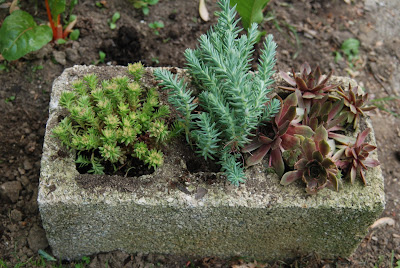
i love succulents. i have quite a collection of them. i am always drooling over the concrete planters displayed at the nursery full of all different kinds of succulents. i found this cinder block at a friends house who was looking to get rid of a large pile. it makes a great container for the heat and dry loving plants.

even bricks make a beautiful planter for succulents. i found these in a debris pile at our csa farm.

old wooden crates make great planters. i am using mine as salad boxes. they are transportable allowing me to move them around to follow the sun.

so look around, keep your eye out and remember one man's trash is another gardener's treasure.
Subscribe to:
Posts (Atom)












